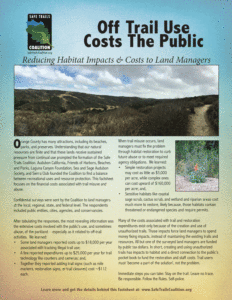 Safe Trails Coalition
Safe Trails Coalition
Orange County is seen as both a destination and home, for many reasons: beaches, theme parks, conventions, the weather, our parks and preserves—this list goes on and on. Understanding that our natural resources are finite—and in some cases, in jeopardy—coupled with the fact that these lands receive sustained pressure from a growing population and visitors prompted the formation of the Safe Trails Coalition. Audubon California, Friends of Harbors, Beaches and Parks, Laguna Canyon Foundation, Sea and Sage Audubon Society, and Sierra Club founded the Coalition to find a balance between recreational uses and resource protection. A condensed version of this information is available by factsheet.
The Conflict
There has been an increase in unsafe trail practices within our protected natural lands, made visible by neglect, erosion, overuse, and degradation of our extensive trail systems. Inappropriate trail use increases the risk and liability for land managers, diminishes the public’s financial investment made to provide the parklands, and leads to the degradation of these natural lands. While some park visitors intentionally create new trails, others are using what they think is a legal trail and perpetuate the problem, perhaps unknowingly. The creation or use of these new trails, called unauthorized, illegal, social or volunteer trails, increases the cost to manage and maintain our parklands. This realization prompted additional research with a group of 10 land managers collaborating with the Coalition to identify the problems and promote solutions.
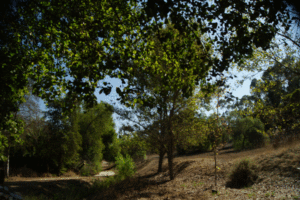
The Inquiry
The Coalition was curious about the actual costs associated with staffing, trail maintenance, and restoration; and when trail use impacts a land manager’s budget. What does it really cost to repair what the public damages while recreating in a park they love?
To understand the true costs, the Safe Trails Coalition requested detailed information from land managers at the local, regional, state, and federal level. All 10 land managers collaborating with the Coalition own or manage land in Orange County. Seven completed the survey and these included public entities, cities, agencies, and conservancies. For purposes of this study and factsheet, the term “land manager” is meant to include all levels and types of entities. Furthermore, not all of the lands included in the survey are open to the public. For clarification, the term “park” represents public and private parks, preserves, and mitigation lands.
The survey covered staffing and volunteer capacity, trail costs, habitat restoration costs, and technologies used to manage the natural resources and trail networks. Unfortunately we found our questions were too detailed for many land managers to respond to. Tracking costs within the operational budgets vary greatly between land managers. The Coalition has opted to keep specific land manager responses confidential, and is instead reporting the information collectively.
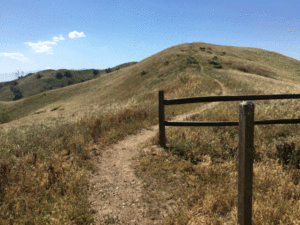
The Results
Land managers can own and manage land (permanently or temporarily) and contract with other entities to manage it for them (permanently or temporarily). Collectively more than 133,800 acres of conserved land exist within Orange County, including hundreds of miles of authorized trails for residents and visitors to enjoy. Most of these landscapes were acquired with specific sets of required conditions on the land. In most instances, those specific conditions or covenants restrict the use of the land. To the general public, however, there may be no obvious distinction between lands owned by one agency versus another, but there actually are distinctions and sometimes restrictions on use. It is up to each park visitor to know the rules of the land and what types of uses—are (or are not) permitted. Using official park maps to know what trails are legal and obeying all park signage is the place to start. The public can download and print these maps for where they will be recreating (i.e., the United States Forest Service, California State Parks, OC Parks, etc.) to be certain the “well-used trail” they might be on is actually an authorized trail. While parks and trails are open much of the time, park visitors should be cautioned to stay alert, watch for signs and postings related to trail or park closures, restoration work, or weather/fire warnings, and then respect the warnings. Most, if not all parks, are closed at night to allow time for the wildlife to interact, forage, and enjoy their habitat without the added stress of people being around.
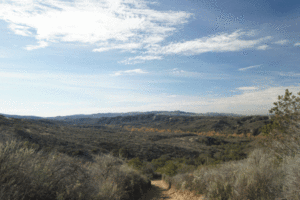
Trails and Restoration
Trail projects and restoration projects can go hand in hand. The aim here is not to judge whether a trail needs to be created or retired, or that restoration work needs to be completed. Instead, the question is simply, what resources are being used to help with trail projects and restoration? When trails are created or restored, staff and/or consultants offer assistance on technical items such as: location, grade, use, difficulty, and carrying capacity. When trails are retired, the assistance focuses on how to eliminate the use of the trail, including: signage, erecting fencing, barriers, incorporating vegetation, and updating maps. The majority of land managers use consultants, volunteers, and partnerships for trail and/or restoration projects. These partnerships cover a wide array of support: individuals, non-profits, cities, and agencies.
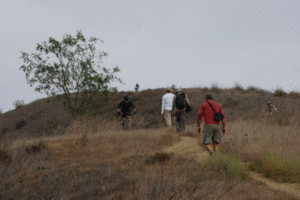
Trail Costs
Understanding the trail basics (length, trail type, surface, use frequency, grade, soil type, and location) are all important considerations when determining potential locations to create or restore an official trail within the park. Conversely, they are also reasons why a trail may need to be retired from the system. Unfortunately, no land manager participating in this survey reported tracking actual expenses related to creating or retiring a trail. Only two land managers reported tracking actual unauthorized trail use. These costs are up to $18,000 per year. And, this cost only exists because of illegal activities. In other words, if these activities had not occurred, this funding could likely be re-allocated within the land manager’s existing budget.
Trail Signage
Signs are important to visitors because they provide direction and for some, reassurance about a trail trip. Signs keep visitors and the parks safer. Replacement signs may need to go up for any number of reasons, such as: vandalism, accidents, or wildfire. One land manager reported higher instances of sign theft, destruction and vandalism, especially in the more remote areas. Few land managers report tracking actual expenditures related to standard park signs and trail signs or mile markers. Simple signs like these cost on average $112 each.
Trail Technologies
There are various trail technologies in existence that allow land managers to track and monitor trail usage. This information helps land managers understand the allocation of staffing, resources, trail needs, budgets, and more. Nearly all the land managers have used trail technologies at one time or another, including: trail cameras, counters, and other methods to determine trail statistics. Of the two reporting agencies that track this cost, one spends up to $25,000 per year on this line item alone.
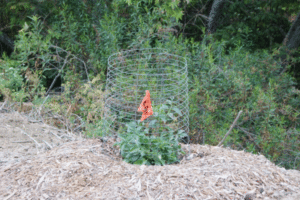
Habitat Restoration Costs
Habitat restoration projects, specifically related to trails, must take into account the type of vegetation adjacent to the trail, the location, its accessibility, the regulatory process (permits), any habitat monitoring requirements there or nearby, and existing or planned resource management plans or environmental review that need to be followed. Restoration, even in its most basic form, is a complicated process with many factors outside of a project proponent’s control, including: weather, rainfall, heat, success ratio, time frame, pest control, etc. Only three of our reporting land managers actually track specific restoration costs by habitat type.
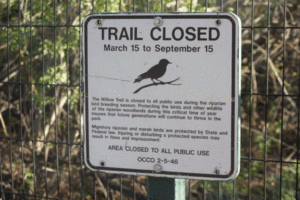
While the goal of understanding actual costs per habitat type was commendable, it was apparently not realistic. The lands are not a single type of habitat. Instead, there are transition zones, with renegade plants that pop up among the native plants, and an array of plant species that make up our natural lands. To further complicate the matter, the cost to restore the land varies on location, staffing, availability of water, and more. And, if there are regulatory requirements, resource management plans, success criteria or permits involved, the costs are higher than simply attempting to create restored habitat. On the low end without extensive regulatory requirements, a one-acre project might cost $3,000. Where there are specific requirements or technical components it may cost upward of $160,000 per acre. For reference, an acre is 40,000 square feet. The more costly restoration projects include sensitive habitats like coastal sage scrub and cactus scrub as well as wetland and riparian areas. These specific habitats are important to the many threatened or endangered species here in Orange County.
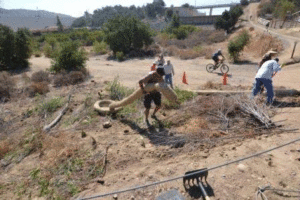
Recommendations
Our land managers are doing a lot of juggling as it relates to the parks, their infrastructure, and law enforcement, among other things within the constraints of their existing systems and budgets. Because of the diverse budgeting procedures across the spectrum of land managers, it may not be realistic to expect that each can include trail or habitat restoration related expenditures as a specific line item. If capturing these specific costs can be incorporated within a budget, then that is recommended so that a baseline can be established and tracked over time.
Park visitors, however, can do their part by investing in the future of our parks. If you use the trails, then help the park by volunteering during clean up days or trail restoration days. There are many opportunities throughout the year to be involved this way both through non-profits, trail groups, conservancies, and the parks themselves. If volunteering isn’t your thing, then donate money to organizations that promote the upkeep of our parks—or the organizations that conserve parkland. Remember that your entrance fees into the parks helps improve the park operations and provides a steadier budget. Buy an annual pass to support the park system instead of parking outside the gates. When you become involved you are investing in the future of our parks and it develops a sense of ownership that you may not otherwise have.
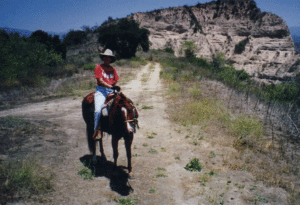
The Conclusion
Many of the land managers in this survey are already experiencing tighter budgets, reduced staff, and deferred maintenance. With the increasing demand on our parks and trails, it is important to remember that every time we step off trail or crush a plant with a foot, a hoof or a tire—there is an impact. Right now, under drought conditions, those impacts have a long lasting consequence because the plants are already struggling to survive with limited water.
So to answer our main question—is yes, it does cost the land managers time, money, and staff resources to fix what was damaged by individuals using unauthorized trails. All but one of the surveyed land managers are funded by our tax dollars. Therefore, creating and using unauthorized trails has impacts to habitat and there has a direct connection to the public’s pocket book to fund the restoration costs.
Please do your part. Stay on the trail. Leave no trace. Be responsible. Self police. These simple actions save us all money in the long run.